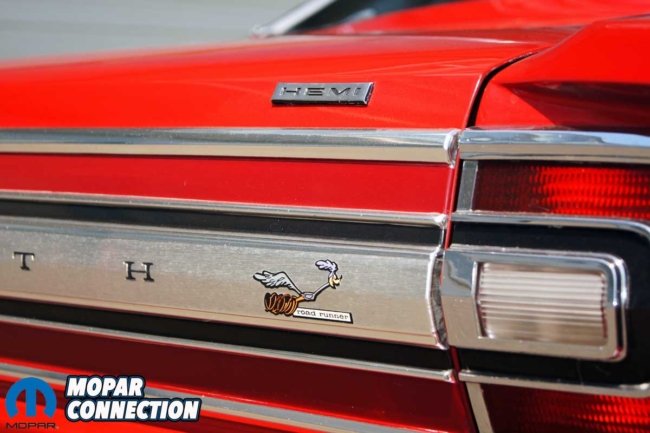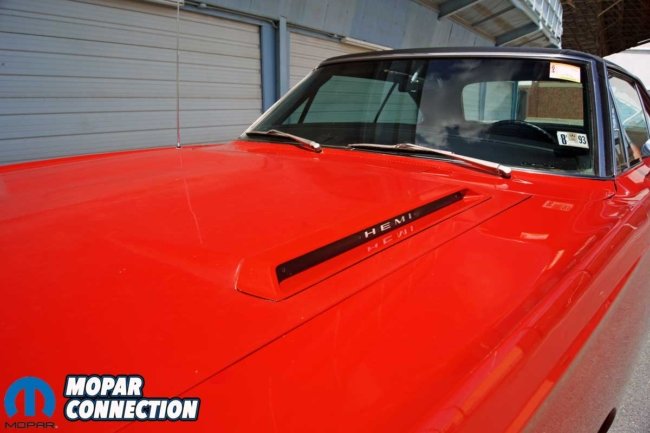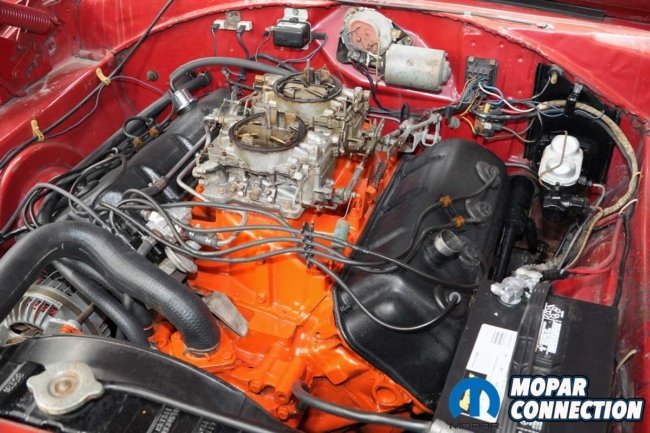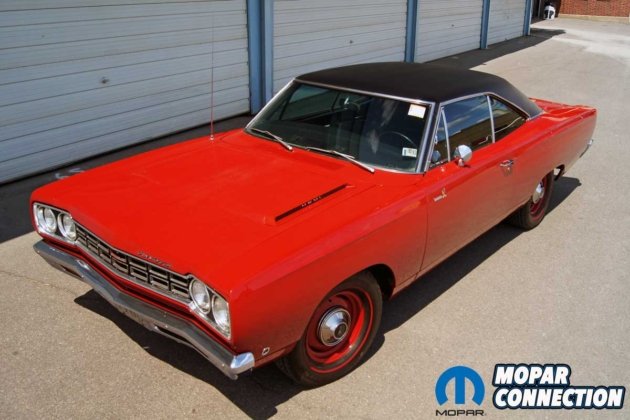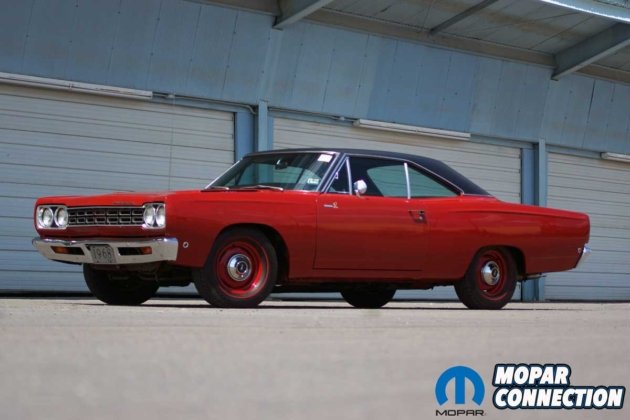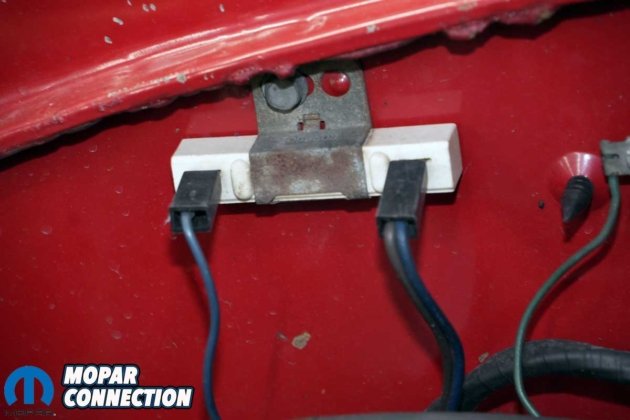
In late 2013, my employer, Pennsylvania College of Technology, added a pair of chassis dynamometer classes to its curriculum as part of a motorsports credential or for open elective courses for transportation majors. The classes focused on installing and evaluating aftermarket performance parts.

Above: The Road Runner was my first photoshoot and feature story. The first Road Runners built were coupes; the hardtop was added late in the 1968 production year. This Road Runner is one of 61 hardtops assembled with a Hemi and a Torqueflite transmission.
A pair of chassis dyno testing classes was a great idea, but the college had one problem. It had a tiny budget to purchase performance aftermarket parts for its 1967 Dodge Dart and 2006 Dodge Charger. In an a-ha moment or out of extreme frustration with the lack of parts needed for the class, I contacted several magazines with an opportunity to work with the college.
Above Left: While the Road Runner icon is easily recognized, the little Hemi emblem informs everyone that this ‘Runner is packing a little more. Above Center: The two non-functional air inlets provided two more locations for Plymouth to advertise what is under the hood. Above Right: Plymouth paid $50,000 to Warner Bros.-Seven Arts to use the Road Runner name and likeness from their Wile E. Coyote and the Road Runner cartoons.
The proposal was that the magazines would have advertisers donate parts to the college. In turn, the students and I would install and evaluate the parts, and I would author a story based on the results. The best part of the proposal was that the college could keep the parts for reuse semester after semester.
Above Left: The Road Runner story was my tenth and first feature. It earned the MoparMAX magazine cover in 2014. Above Right: After MoparMAX magazine went under, the story was rewritten in 2017, and again, it found its way to the cover, this time in Chrysler Power Magazine.
However, the problem was no editor was willing to stick his (her) neck out for an unknown college professor without any writing experience. Additionally, the chassis dyno class was new, so I did not have volumes of data to share with the editors about how the Penn College cars or the dyno performed. Consequently, I was politely turned down or did not hear a thing from them.
Above: The Road Runner looks great whether coming or going. Even though it looked decent during the 2014 photoshoot, there were dings, dents, thin paint, touched-up paint, and previous rust repairs. Although the odometer did not accumulate a bunch of miles (72K miles) in its 57 years, the ‘Runner was not a trailer queen.
There was one exception. Richard Kratz, editor of MoparMAX Magazine, was interested in the concept. He asked me to draft a 500-word story with X number of photos and captions and turn it in by a specific date and time. Although this task was daunting for someone without prior writing experience, I was determined to make it work.
I met all the requirements, and to my delight, Richard found the test story acceptable. In January 2014, Richard introduced me to the MoparMAX readers, and in February, my first story, “How Did I End Up Here?” was in print (online). That marked the beginning of my writing career in the automotive industry.
Above Left: The Road Runner came with the basic poverty caps and body-colored wheels. The original tires were red striped bias-ply tires. Now, it rides are radial red stripe BF Goodrich tires. Due to their age, the tires will be replaced prior to getting the Road Runner on the road. Above Right: The interior of the Road Runner is spartan, like a taxi cab. The instrumentation is basic with engine temperature, ammeter, and fuel gauges. The ‘Runner was ordered with a clock, which unfortunately has not worked for decades.
After writing one tech story per month for several months, I asked Richard if he would accept a feature story if I put one together. He said he would look it over but made no guarantees. To me, the best opportunity to get a feature story published would be to find a great looking 426 Hemi car. In September 2014, I attended a Carlisle Events show in Bloomsburg, Pennsylvania. While at the event, I noticed a 1968 Plymouth Road Runner with a 426 Hemi.
I looked the car over for nearly an hour, shooting as many photos of the engine and closeups as possible, but the owner was nowhere to be found. I moved on but returned several times during the day to see if the owner had shown up. Finally, I was able to meet the owner, Jim Shelhamer. He was the second owner and had owned the Road Runner since 1975.

Above: The Road Runner was delivered on March 12, 2025. The Hemi idled well even though the ambient temperature was hovering around 32°F. The ‘Runner was delivered to the house via roll back during passing snow flurries.
Although I had never done a photoshoot, it went great. Richard accepted the story, which I named “One Rare Bird” because the Road Runner was a 1-of-61 hardtops made with a Torqueflite in 1968. The Road Runner earned the November 2014 cover and had a nice spread in the magazine.
When MoparMAX Magazine folded, I rewrote and presented the story to Deaven Butler at Chrysler Power Magazine. In the Jul/Aug 2017 magazine, the Road Runner earned the cover again, and the story was named “A Very Rare Bird.”
Above Left: The Hemi is stock and retains most of its original parts. It appears the driver’s side fender apron was subjected to a battery acid spill, but the factory fender tag is in place. The tag, the radiator support, and the trunk opening lip all have the same serial number – it is an actual Hemi car. Above Right: The AFBs need some cleaning and adjustments, but they are complete. The rear carburetor is the correct unit for 1968. However, the front carburetor is from 1966. All the springs, linkages, and kick-down linkage are original and accurate.
Fast-forward to MLK Day, 2025. I had to go to a dealership to have a fuel pump recall performed on my Civic. Unfortunately, Honda would not let me perform the work myself. While waiting for the repair, the sales manager came over and asked if I was still into old Mopars (he has several vintage Ford products). When I told him I was, he stated a local Hemi car was for sale. I informed him I was sure it would be out of my price range.
Above Left: The original trunk mat is in excellent condition. The underside of the trunk lid has the jack usage instructions and F70X tire size written in crayon. Above Right: The trunk contains the original jack and a bias-ply spare tire. The tire still holds air, but it is not roadworthy.
He flipped through his phone and turned it toward me once he found a photo. I was floored to see one of my photos of the Road Runner. Jim (owner of the ‘Runner) and I would see each other at least twice a year at car events, and he never mentioned he was planning to sell the car. The sales manager told me the service manager was a close friend of Jim’s. I immediately approached the service department and discussed the vehicle with the manager.
Four people had been out to look at the car and passed. A person was coming to see it in three days (Thursday). I asked what the sales price was, and I was stunned for the second time in less than ten minutes. The sales price was a steal (grand theft). I did not have Jim’s phone number with me, but once I got home, I called Jim, and he confirmed the price and said that someone was coming out to look at the car. He said I could look it over the day after his scheduled meeting.
Above: A few things in the engine bay are incorrect. The Road Runner has an electric fuel pump, and the factory fuel lines for the carburetors are hacked up to accommodate a Holley pressure regulator. The positive battery cable is in rough shape. The ignition coil has been moved under the washer reservoir, and the heater hose brackets (two) are missing. Lastly, the radiator hoses are extremely old and soft, and the radiator cap cannot hold pressure, which is probably good because of the hoses’ condition. All of these errors will be repaired in short order.
The day I was to check out the Road Runner, I got a phone call. Jim told me I was going to be mad at him. He had sold the Road Runner. My heart sank. Likely, I would never have another chance to own a Hemi car. Then he told me he sold it to a used car lot. I was extremely disheartened. Likely, the car would quickly be flipped and long gone. The rare bird had slipped through my fingers, leaving me with a deep sense of loss.
Above Left: The coil currently resides under the washer reservoir. The loose wire is a tachometer lead, but the ‘Runner does not have a tach, so it will be taped back when the coil is moved back to its correct location. Above Center: The voltage regulator in the car is functional, but it is not the OEM. It will be replaced when a correct unit is found. Above Right: The ballast resistor has the correct part number for a 1968 RR.
For the next few weeks, I did several online searches for other Hemi cars, but they were all too expensive (for my budget) or too far away to view in person. Despite the setbacks, I was determined to continue my search for a vintage Mopar convertible, a Hemi car, or a big-block E-body, which had been my focus for over a year.
Above Left: The Road Runner’s trunk floor is solid. All it needs is a good cleaning; when it is time for a restoration, it will need a fresh coat of paint. Above Center: The rear seat, belts, and panels are in excellent condition. The plastic belt storage clips are in place and functional. They keep the belts correctly in place. Above Right: The original carpet must be replaced as it is faded and raggedy. The front seat belts (and shoulder belts) are worn and will require new webbing. However, the chrome and buckles are in great shape.
Then, in one of my searches, I found the Road Runner, which was to be auctioned in North Carolina within the week. The news filled me with a mix of excitement and apprehension. I registered for the auction, fully aware that the car’s price was likely to be exorbitant (beyond my budget), with all the added costs and fees, and then I would have to ship it back to PA if I were to win.
When the day of the auction started, the price of the Road Runner quickly moved out of my price range. Saddened, I decided to view a 426-wedge convertible Sport Fury in Pittsburgh that, unfortunately, turned out to be a rust bucket.
Above Left: Inside the glovebox is a sticker for 24-hour towing from Dom Morino’s Colony Chrysler, Plymouth (and Imperial). Above Right: Although cool for nostalgia, the 8-track player, which operates correctly, will be deep-sixed. The Road Runner purchase included two boxes of 8-track cartridges.
In the meantime, the Road Runner did not make the reserve and remained in limbo for a week. I emailed the used car lot inquiring about the price of the Road Runner. The next day, I was contacted by a rep from the car lot, and after several calls, we agreed on a price for the car. While not the steal the used car lot received, I got a great price. The Road Runner was recovered from North Carolina and delivered to my house by the used car lot.

Above: The Road Runner needs work, but it is a good starting point, and its pedigree is strong. As replacement parts are gathered, the clutter of the spark plug wires and wiring harness will be addressed.
On March 6, 2025, I became the third official owner of the 72K-mile 1968 Plymouth Hemi Road Runner. Richard H. French (and Winnifred French, co-signer) purchased the car from Dom Marino’s Colony Chrysler Plymouth Imperial (just outside of Detroit, MI) on July 5, 1968. Richard had ordered it in early June.
Above Left: While all the suspension parts appear to be the originals, except a newer idler arm, it will take some time to verify the originality of each part. Above Center: Both exhaust resonators were replaced in April 1973, and although they are still on the RR, they are in terrible shape. They have been welded back together on several occasions. Above Right: The mufflers are a new addition in the last six months. They are cheap but will work for now.
From 1968 to 1975, Richard put 61K miles on the Road Runner. In 1975, Richard found a 1968 Super Stock Plymouth Barracuda that caught his fancy. His dad told Richard that one had to go because one car in the garage was acceptable, but two were not. So, Richard listed the Road Runner in the classified ads section of Road & Track Magazine. Jim saw the ad, drove to Detroit from central PA, and hauled the Road Runner back. In 50 years, Jim added 11K miles.
Above: The front seat has seen better days. Several areas of the cover are held together with tape. New front seat covers, re-webbed front belts, and new carpet will set off the interior.
Now that the Road Runner is in my garage, I have already started a detailed car inventory. It has so many original parts that it is incredible, but it still needs work. I will work with magazine sponsors to update the Road Runner with specific date-correct components and search for NOS parts unavailable from the sponsors.

Above: The Road Runner’s grille is in excellent condition. The chrome around the grille and the quad-headlight design shines well. The factory sway bar is barely noticeable and neatly tucked under the chassis. The K-member has the Hemi skid plate projecting downward.
The primary focus in the short term is to get the car roadworthy and then enjoy it, but eventually, the body will need some minor metal repair, and the thin paint, chips, and dings can be addressed at that time. The depth of the restoration will be determined later after further investigation of the car’s overall condition.
Above Left: The vinyl top and chrome around the windows are all the original pieces installed on the Road Runner in June 1968. Above Right: According to published data, the purple “beep, beep” horn was unavailable for the 1968 models. However, there are claims that reveal some late ’68 models got one. Also, data states that only one horn was standard, but the factory wiring schematics show two, and the wiring on the Road Runner has provisions for two horns. The purple and black horns take care of the beep, beep, which is the sound associated with a Road Runner. Plymouth paid $10,000 to develop the correct sound.
To start the repairs, Mopar Connection Magazine will cover basic car maintenance, no-cost, low-cost repairs (ignition, carbs, brakes, etc.), updates to the fuel and cooling systems, and door hinge repairs. That list will expand as more systems and subsystems are assessed. So, strap in; it will be a fun ride putting some life into Project Rara Hemious Birdicus.



